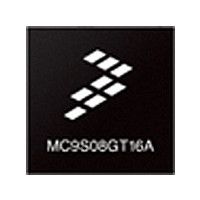MC9S08GT16CFB Freescale Semiconductor, MC9S08GT16CFB Datasheet - Page 272

MC9S08GT16CFB
Manufacturer Part Number
MC9S08GT16CFB
Description
Manufacturer
Freescale Semiconductor
Datasheet
1.MC9S08GT16CFB.pdf
(290 pages)
Specifications of MC9S08GT16CFB
Cpu Family
HCS08
Device Core Size
8b
Frequency (max)
20MHz
Interface Type
SCI/SPI
Program Memory Type
Flash
Program Memory Size
16KB
Total Internal Ram Size
1KB
# I/os (max)
36
Number Of Timers - General Purpose
4
Operating Supply Voltage (typ)
2.5/3.3V
Operating Supply Voltage (max)
3.6V
Operating Supply Voltage (min)
2.08V
On-chip Adc
8-chx10-bit
Instruction Set Architecture
CISC
Operating Temp Range
-40C to 85C
Operating Temperature Classification
Industrial
Mounting
Surface Mount
Pin Count
44
Package Type
PQFP
Lead Free Status / Rohs Status
Not Compliant
Available stocks
Company
Part Number
Manufacturer
Quantity
Price
Company:
Part Number:
MC9S08GT16CFBE
Manufacturer:
FREESCALE
Quantity:
1 831
Company:
Part Number:
MC9S08GT16CFBE
Manufacturer:
Freescale Semiconductor
Quantity:
10 000
Part Number:
MC9S08GT16CFBE
Manufacturer:
FREESCALE
Quantity:
20 000
Company:
Part Number:
MC9S08GT16CFBER
Manufacturer:
Freescale Semiconductor
Quantity:
10 000
- Current page: 272 of 290
- Download datasheet (2Mb)
Appendix A Electrical Characteristics
272
1
2
3
4
5
6
7
8
Output clock ICGOUT frequency
Minimum DCO clock (ICGDCLK) frequency
Maximum DCO clock (ICGDCLK) frequency
Self-clock mode (ICGOUT) frequency
Self-clock mode reset (ICGOUT) frequency
Loss of reference frequency
Loss of DCO frequency
Crystal start-up time
FLL lock time
FLL frequency unlock range
FLL frequency lock range
ICGOUT period jitter,
Internal oscillator deviation from trimmed frequency
Self-clocked mode frequency is the frequency that the DCO generates when the FLL is open-loop.
Loss of reference frequency is the reference frequency detected internally, which transitions the ICG into self-clocked
mode if it is not in the desired range.
Loss of DCO frequency is the DCO frequency detected internally, which transitions the ICG into FLL bypassed external
mode (if an external reference exists) if it is not in the desired range.
This parameter is characterized before qualification rather than 100% tested.
Proper PC board layout procedures must be followed to achieve specifications.
This specification applies to the period of time required for the FLL to lock after entering FLL engaged internal or external
modes. If a crystal/resonator is being used as the reference, this specification assumes it is already running.
Jitter is the average deviation from the programmed frequency measured over the specified interval at maximum f
Measurements are made with the device powered by filtered supplies and clocked by a stable external clock signal. Noise
injected into the FLL circuitry via V
percentage for a given interval.
See
CLKS = 10, REFS = 0
All other cases
Low range
High range
Low range
High range
Low range
High range
Long term jitter (averaged over 2 ms interval)
V
V
DD
DD
Figure A-10
= 1.8 – 3.6 V, (constant temperature)
= 3.0 V ±10%, –40° C to 85° C
4, 6
(V
DDA
Characteristic
4, 5
4, 7
= V
3
measured at f
DDA
2
Table A-9. ICG Frequency Specifications (continued)
(min) to V
DDA
1
ICGOUT
and V
MC9S08GB/GT Data Sheet, Rev. 2.3
DDA
Max
SSA
(max), Temperature Range = –40 to 85°C Ambient)
and variation in crystal oscillator frequency increase the C
8
f
f
ICGDCLKmax
ICGDCLKmin
f
Symbol
f
Self_reset
n
ACC
ICGOUT
t
t
C
t
n
t
CSTH
f
f
CSTL
Lockh
Unlock
f
Lockl
LOR
LOD
Self
Lock
Jitter
int
f
f
ICGDCLKmin
Extal
f
lo
–4*N
–2*N
Min
5.5
0.5
(min)
50
—
—
—
—
—
—
—
8
5
(min)
Typical
± 0.5
±0.5
430
—
—
8
4
Freescale Semiconductor
f
f
f
ICGDCLKmax
ICGDCLKmax
Extal
(max)
Max
10.5
500
4*N
2*N
1.5
0.2
40
25
±2
±2
—
—
2
2
(max)
Jitter
counts
counts
% f
ICGOUT
MHz
MHz
MHz
MHz
MHz
MHz
Unit
kHz
ms
ms
%
ICG
.
Related parts for MC9S08GT16CFB
Image
Part Number
Description
Manufacturer
Datasheet
Request
R
Part Number:
Description:
Manufacturer:
Freescale Semiconductor, Inc
Datasheet:
Part Number:
Description:
Manufacturer:
Freescale Semiconductor, Inc
Datasheet:
Part Number:
Description:
Manufacturer:
Freescale Semiconductor, Inc
Datasheet:
Part Number:
Description:
Manufacturer:
Freescale Semiconductor, Inc
Datasheet:
Part Number:
Description:
Manufacturer:
Freescale Semiconductor, Inc
Datasheet:
Part Number:
Description:
Manufacturer:
Freescale Semiconductor, Inc
Datasheet:
Part Number:
Description:
Manufacturer:
Freescale Semiconductor, Inc
Datasheet:
Part Number:
Description:
Manufacturer:
Freescale Semiconductor, Inc
Datasheet:
Part Number:
Description:
Manufacturer:
Freescale Semiconductor, Inc
Datasheet:
Part Number:
Description:
Manufacturer:
Freescale Semiconductor, Inc
Datasheet:
Part Number:
Description:
Manufacturer:
Freescale Semiconductor, Inc
Datasheet:
Part Number:
Description:
Manufacturer:
Freescale Semiconductor, Inc
Datasheet:
Part Number:
Description:
Manufacturer:
Freescale Semiconductor, Inc
Datasheet:
Part Number:
Description:
Manufacturer:
Freescale Semiconductor, Inc
Datasheet:
Part Number:
Description:
Manufacturer:
Freescale Semiconductor, Inc
Datasheet:











